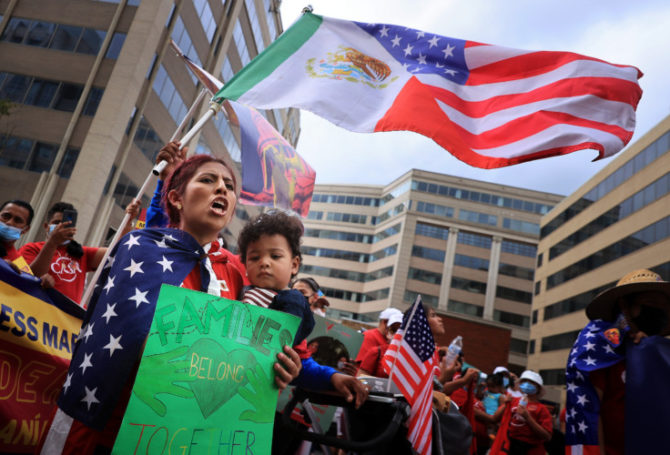
Amid partisan bickering and negative TV ads, a bipartisan group of senators has resumed conversations to revise US immigration policy, including provisions for migrant farmworkers, children with aged-out visas and foreign workers marooned in “green card” oblivion.
The challenge will be finding a medley of immigration issues – or even one immigration issue – that can attract at least 60 votes in the Senate to overcome a filibuster.
The conversation involves Senate Judiciary Chair Richard Durbin, D-Ill, and Senators Alex Padilla, D-Calif, Thom Tillis, R-N.C., and John Cornyn, R-Texas. In separate interviews, all four confirmed talking, but characteristic the first meeting as organizational and exploratory. Tillis said the foursome identified “bigger concepts that we feel like are pretty important to be baked into anything that could get bipartisan support.”
Resumption of bipartisan talks comes a year after Democrats tried unilaterally to legalize millions of undocumented immigrants as part of a budget reconciliation package, which isn’t subject to the filibuster. The effort fizzled because of internal disagreements in the Democratic caucus and a ruling by the Senate Parliamentarian the provision wasn’t germane.
More problematic is the campaign clatter over President Biden’s decision to phase out Title 42, a Trump-era policy to keep asylum-seekers in Mexico while their cases are heard in US immigration courts. The policy was justified as a public health emergency during the COVID-19 pandemic. Biden wants the policy to go away because the pandemic has ended. Republicans warn of an immigrant surge and some Democrats fear US immigration officials will be overwhelmed. Biden administration officials contend Title 42 hasn’t worked that well, didn’t discourage a major surge in asylum-seekers last year and has worn out its welcome with Mexican authorities.
The post-pandemic inability of US businesses, hospitals and farms to hire enough workers has lit a different kind of fire under Congress to consider immigration reform.
Biden’s plan to end Title 42 is on hold following a federal court ruling blocking the action. Cornyn said the Title 42 issue, if unresolved, could be a barrier to a congressional immigration compromise. He also said the Biden decision on Title 42 provides Congress with a “sense of urgency” to act.
US immigration law hasn’t changed a great deal since 1986 with the passage of the Immigration Reform and Control Act, which made it illegal to hire or recruit undocumented immigrants. Congress believed the 1986 legislation would stop illegal immigration through a mix of amnesty for undocumented immigrants already in the country and stiffer border enforcement. The exact opposite occurred. Unauthorized immigrants jumped from an estimated 5 million in 1986 to 11.1 million by 2013. Outlawing the employment of undocumented immigrants didn’t pan out either.
In 2013, the Senate passed bipartisan immigration legislation by a vote of 68-32 that would have made it possible for some undocumented immigrants to gain legal status and eventually citizenship. However, the bill wasn’t considered in the House and it died. No immigration reform legislation has moved since then, despite campaign pledges by presidential and congressional candidates.
President Obama raised hackles with his executive action called Deferred Action for Childhood Arrivals, commonly referred to as DACA, which was intended to protect the children of unauthorized immigrants from deportation. President Trump rescinded DACA in 2017, but the US Supreme Court on a 5-4 ruling in 2020 said Trump’s action was arbitrary and capricious, which effectively left DACA – and millions of so-called Dreamers that it protected – precariously in place.
In his campaign, President Trump pledged to build a US-Mexico border wall. During his administration, portions were built amid arguments over the effectiveness of a wall, its cost and its impact on landowners. Segments of the wall, especially near San Diego, were raised to 30 feet, which has led to a growing number of traumatic injuries from desperate immigrants who jump or fall after scaling the wall, which was designed to be unscalable.
The post-pandemic inability of US businesses, hospitals and farms to hire enough workers has lit a different kind of fire under Congress. Mike Rogoway of The Oregonian recently wove together interesting statistics, noting Oregon has 100,000 posted job vacancies in February and, at the same time, 100,000 fewer foreign-born workers between the ages of 25 and 54 than it had as recently as 2016.
In 2016, the United States was still adding 1 million immigrants every year. Now net immigration has dropped to around 200,000 annually. Meanwhile, there are 11 million job openings in America, but only 4.6 million Americans on unemployment. Farming, factory, hospitality and health care jobs, which are going unfilled, are often jobs held by immigrants.
Another factor quietly at work on the immigration issue is the declining US birthrate, which has fallen from 69.3 percent per 1,000 women between the ages of 15 and 44 in 2007 to 55.8 percent in 2020. The largest birthrate decline is by women under age 30.
Declining birthrates translate into a demographic dilemma for the United States with an aging population. In 2020, 16 percent of the US population was 65 years or older and is expected to reach 20 percent as early as 2040. While many Americans are living longer and continuing to work, that won’t make up for a smaller pipeline of new working-age adults.
The current and projected population trajectories may become the driver that persuades Congress it’s time to let in legally more migrants to fill gaps in a wide array of service, manufacturing, construction and professional jobs.




